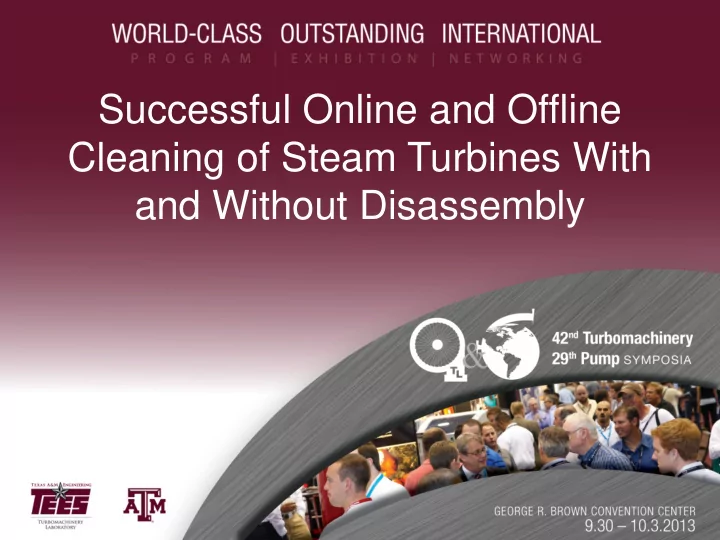

Successful Online and Offline Cleaning of Steam Turbines With and Without Disassembly
Successful Online and Offline Cleaning of Steam Turbines With and Without Disassembly Bladimir Gomez Supervisor, Rotating Equipment Engineering PDVSA CRP Refinery Barry Snider, MBA, PE President, Small Hammer Incorporated
The Problem • steam turbines losing power and speed • several occurrences isolated to multistage turbines driving critical compressors • governor/steam valve unable to maintain desired rpm • unit production reduced • lost revenue
The cause of the problem? fouling of turbine rotor blades and static guide vanes
Water Soluble Chemicals [NaCl, NaOH] Bound with Insoluble Oxides [Fe, Si, Al] > 50 ppb
Photos showing fouling of diaphragm guide vanes
Fouling occurs in stages prior to saturation Fouling Saturation Zone Zone STEAM FLOW
To clean the turbine online, move the saturation zone back to the fouling zone Fouling Saturation Zone Zone STEAM FLOW
Cleaning Methods Considered 1. Offline Mechanical Cleaning with aluminum oxide • Guaranteed results • Allows for inspection of rotor and other components • Requires disassembly • Extended downtime • Utilizes multiple resources • Intrusive
Cleaning Methods Considered 2. Offline Slow-Roll Soak and Flush with Hot Water • No disassembly • Short Downtime • Low Risk • No modification of facilities • Results not guaranteed
Cleaning Methods Considered 3. Online Manipulation of Saturation Point • No disassembly • No downtime but some lost production • Medium risk managing axial thrust • No modification of facilities • Results not guaranteed
Cleaning Methods Considered 4. Online Water Injection into Steam at Turbine Inlet • No disassembly • Medium risk managing axial thrust • No downtime for cleaning but • Requires modifications of facilities (downtime) • Results not guaranteed
Turbine #1 3-Stage Turbine, No Extraction, No Turning Gear Selected Cleaning Method – 1. Offline Mechanical Cleaning (disassembly)
Turbine #1 Performance Before and After Cleaning kRPM ~ 100% Steam Flow klb/hr Recovery Steam Valve Opening % 5.5 100 210 Offline Mechanical Cleaning 7 days 100 0 4.5 June July August September
Turbine #2 10-Stage Turbine, Has Extraction, Has Turning Gear Selected Cleaning Method – 2. Offline Slow Roll Soak with Hot Water (no disassembly)
Slow-Roll Soak Cleaning Procedure 1. Develop Plan for measuring conductivity (hardness) of water exiting turbine 2. Shut down turbine/compressor and place on slow roll using turning gear 3. Close all valves except for sentinel valve and leaving free flow open to/from condenser 4. Slowly fill turbine to 100% by flooding condenser with hot water/condensate allowing overflow from the sentinel valve 5. Allow turbine to slow roll with water flowing for several hours while monitoring conductivity (hardness). When conductivity becomes equal to water flowing in, cleaning is complete.
Turbine #2 Performance Before and After Cleaning kRPM Steam Flow klb/hr ~ 100% Steam Valve Opening % 100 4.5 Recovery 250 Extraction Flow 4 days Offline Slow-Roll Cleaning 150 0 3.5 June July August September
Conductivity Reduction During Cleaning Conductivity of Condensate Muestras de condensado de vacío en Lavado de la Turbine #2 During Cleaning Numero de muestras Conductividad (µS/cm) Muestra inicial o patrón 19,04 Conductivity (µS/cm) 1200 Muestra 1 (12/08/12 8am) 1178 1100 Muestra 2 (12/08/12 4pm) 560 Muestra 3 (13/08/12 8am) 493 1000 Muestra 4 (13/08/12 4pm) 119 900 Muestra 5 (14/08/12 8am) 92 800 Muestra 6 (14/08/12 4pm) 19,4 Muestra 7 (15/08/12 8am) 19,4 700 Muestra 8 (15/08/12 4pm) 19,4 600 500 400 300 200 100 0 M1 M2 M3 M4 M5 M6 M7 M8 Time (4 days)
Conclusions Solid deposits of both soluble and insoluble material can be safely and effectively removed from turbine blades and guide vanes. There are removal methods available that do not require disassembly of the turbine.
Conclusions The key mechanism for removing the solids without disassembly of the machinery is to dissolve the soluble material thus releasing the insoluble material. This may be done by: 1. Flushing with hot water while slow rolling the turbine or 2. Moving the saturation zone back through the fouling zone at normal RPM while monitoring conductivity (hardness).
Recommend
More recommend